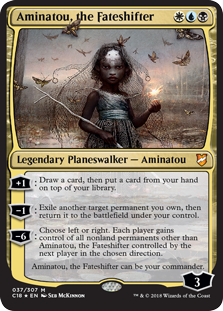
Until this year I had never cast a card from the command zone. I am not much into multiplayer magic and so never found myself involved in any commander games. Brawl and 1v1 commander piqued my interest when they started to become things and I made a bunch of decklists up but never played any of them for one reason or another. Recently I have been playing some creative and unusual casual formats with strangers on a forum! It makes it sound like the MtG equivalent of dogging... Branching out a bit from cube and learning new things, letting other people decide the formats. It has been fun. One of those events was a brawl style deck, 60 card constructed singleton with a commander and colour locking accordingly, and 25 life for what it is worth. We were allowed cards from original Rav block, Timespiral block and 10th edition. I chose Vorosh purely because he was the only legend in those colours and I wanted to play a Sultai deck with what seemed to have all the best cards! The event was a lot of fun but the main takeaway I had from it is how good the commander rule is. It does several things incredibly well and adds a whole extra layer of deliciousness to game play and deck design. I just built what I thought was a good cube style 60 cards from the pool and didn't think that much about my commander. I certainly didn't build with him in mind or for any sort of synergy with him. He was just a big dorky threat at the top of my curve that let me play a three colour deck. In the games however I learned the value of commanders and what they do for the game.

I had always appreciated a number of qualities that commander has as a format and thought I understood why it was so popular. It has a social element. It has a collect and gradual improve element almost like an RPG. It has both creative and other expressive elements in it, far more so than any other magic format allow for. It is a format where you can do things you cannot in any other. Big cards are substantially more playable in higher life total multiplayer games and so the effective increase in card pool and game time allows for vastly more combos and cool interactions. Commander really lets you explore and experience the fullest range of what magic has to offer. It has a nice self balancing political element too which ensures a much more even and inclusive win distribution. All these are great qualities for a format to have and so I had not bothered looking for more assuming that was more than enough to make the format great and account for its popularity. As such I didn't really probe or appreciate how good the commander rule was. I kind of wrote it off as almost a flavor element. Certainly it is superfluous to requirement in that you could still play big library, big life, singleton multiplayer without it. That really should have been a clue. Rules that you don't need only stick when they really add something and it turns out that the commander really does.
My one outing with a commander made me hungry for more. I was jealous of the commander players and the treats they have in their command zones! I want such things for cube. I want to take it further and cram all sorts of things into command zones. The worlds of possibility open up so much by doing so little. I have also always a little jealous of people and their singleton-rule breaking cubes. Mostly for the increased options on viable builds and viable cards, even if it would reduce the overall number of distinct cards played. I never entertained the idea simply because there is no way I am getting four copies of all the cards I want! It simply wasn't realistic or even sensible. Playing events with a commander however adds basically no demand on my card collection and adds a solid amount of overall depth like breaking singleton would do.

So what is the depth brought by a commander? Why is it so good? I don't really know where to start here as the list is long and each point almost certainly extensively deep in what could be discussed about it. The most notable thing is the build potential. Since playing my Vorosh deck I keep designing cube decks and then realizing that my build would be vastly superior if I could utilize the commander slot. There are loads of cool legends that are great fun to build around but fail due to a wide selection of reasons. They could be too vulnerable. They can lack redundancy. This lack of redundancy then cascades into solutions with yet more potential problems such as lack of tutors in your colours or simply an archetype that does not have the freedom to forgo tempo cards for selection cards. A lot of new cards that have been getting a lot of commander hype has brought this to light in cube. Cards like Nikya of the Old Ways, Slimefoot the Stowaway and Teysa Karlov are fantastic build around cards but none are easily abused in cubes for these various issues. If I imagine a cube deck with these as a commander however and things start to look a lot more worthwhile!
I shall likely loop back round to this build around element and how it opens up the card pool. First we have to look at some of the other things that make the commander so good. Firstly it is just value. Your commander is an extra card in your opening hand effectively. It is then a source of ongoing value. It performs the role of a mana sink in a lot of ways. Your commander gets to be a little like a Kessig Wolf Run or a Duskwatch Recruiter. Some mana fueled inevitability and value. That adds to consistency greatly. It lets you play more land safely without fear of a ruinous flood. The commander tax of two is perfect. At one it would be oppressive and people would just shove their commander down your throat till you were dead and at three it would be prohibitive and the mode number of times you would see a commander in a game would be one. It is enough of a tax to make killing commanders worth doing even if less valuable than killing something that can't come back. It means you only do so when you need to, which given the strength of most commanders, is a lot of the time.
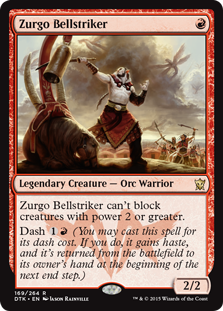
Next up is another element of consistency that isn't brought about by having free sources of value and ways to spend your mana each game. It comes in the consistency of always having one card. You are certain to be covered in one area of your plan. This is great for a synergy deck trying to abuse the effects of a card like Teysa or Nikya but it is also great for all the other kinds of deck too. A deck with Isamru or Zurgo knows it always has a one drop play. You can thus greatly increase the power level of your deck by playing more high powered cards in the place of one drop threats because you are always making that one drop threat on turn one when they are best. My Vorosh performed this role for me but at the top end of my curve. I didn't really need a finisher, my whole list was value and disruption. My deck got me ahead and Vorosh would close things out. I could run Dark Confidant while still having a big top end. You cannot often build sensible decks without a commander that contain Dark Confidant and that consistently make a six drop on or by turn six. A commander can wholly occupy a curve slot, they can fulfill a role your deck needs, or they can simply be the necessary redundancy in effect to make a synergy build around possible.
As a general point I think that a slightly higher life total and (effective) starting hand size is a plus to the game. There is sufficient balance and power in the game that increasing the flow of resources generally seems like a good thing. It has the overall effect of reducing bad RNG and increasing the option density of games. I have heard a wide array of suggestions on this matter from more starting cards and life to drawing an extra card each turn. None sound like bad ideas. Twenty life felt like a lot when Serra Angel was one of the most potent threats in the game. With what we have now the game can all be over a bit abruptly. The general increase of tempo puts red in a sticky spot too from a design perspective. If the creatures keep pace with the power creep in other colours then the finishing power of direct damage is oppressively good. This is currently the case in my cube with red having the largest win percentages fairly comfortably. Failing to keep up with power creep on red dorks however limits the colour immensely and makes it narrow. This is a bit of a tangent but it is here to illustrate why a bit of extra life with those extra cards opens up a lot of design space while also improving the game. Commander heads up is not as refined as the multiplayer version as it has been too directly translated across. It completely rules out aggressive decks by having 60 or 100 card singleton decks and obnoxious life totals. I think heads up play would benefit from going up to 24 or 25 starting life total but I think any more than that, regardless of format and starting hand size, would start to hurt the game as it currently looks. The large deck sizes hurt aggro and combo significantly more than midrange or control and the commander rule helps combo more than it helps aggro. Even a shift from 40 card libraries to 50 card ones has a huge impact on the quality of decks in cube. All the combo and aggro lose some win percentage and all the slower decks pickup that loss. Because of this the best case for staying at 20 life resides in heads up play with larger singleton decks. Playing with a commander and a 40 card deck feels like it gives a big edge to the aggressive decks but either increasing library size or starting life total a bit or even both would seem to help.
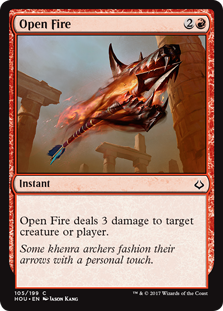
I thought what I want to do is build cube decks with commanders. A nice clean 40 card list with a commander, probably added in extra as a 41st card rather than dropping deck size down to 39 more for the simplicity of keeping as much unchanged as possible. I thought this would greatly increase the viability and number of decks I could build for cube. Then I thought, why am I restricting this to commanders? Why don't I just open it up to any historic card? How about any permanent? What about any card at all? How broken is having a Lightning Bolt as your commander? This was all before I heard of Oathbreaker as a format! Always starting with a Bolt in your hand is great but it probably isn't as good as always having that one drop beater. Having Open Fire also in your opening hand is nice but a whole lot less good than your Bolt and beyond that the value falls off rapidly. Any card is probably a bit dangerous, especially if you want to include the power. The thing is, the benefit is always symmetrical. You might have your deck massively improved by your commander but so will your opponent. That symmetry combined with the on point commander tax ensures a reasonable degree of balance. Everything would get better but some more than others. Most relevantly though, much much more would become viable. I am absolutely going to test out running conventional commanders in a cube style smaller deck. I am probably going to tinker a little bit with life totals too. If the commanders work out well I will extend that out first to historic stuff, then permanents and then spells. Each gets increasingly more distant from the trodden path and contains more unknowns and potential imbalance but that is why we call it testing. Any permanent for example lets you play a deck with a land as a commander and a brutally land light list potentially? You could limit it to things you can cast but that doesn't preclude Mox from doing similar things. All in all, I am very impressed with the commander rule and would like to see it used more across the magic spectrum. Shame they don't do quirky things in invitationals any more, that would have been a perfect arena to showcase a heads-up constructed format with the commander rule.
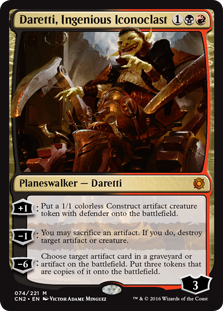
I write this final part of this article some months after writing the rest as I have done a number of sealed deck and draft "commander cube" events and learned a great deal from them. I can fairly confidently say that you want to stick to actually allowable commanders for the limited events. Mostly this is because the cheaper your commander is the better and more impactful it is as a general rule. Three mana planeswalkers are oppressive commanders as are high powered four mana ones. They do too much too reliably on their own to want them all as commander options. Planeswalkers are just a bit snowbally for limited decks to cope well with. As you move towards constructed events I think you can get away with allowing more exotic things in the command zone if it takes your fancy but in limited games the narrower pool of options keeps things fairer and more diverse. The few planeswalkers you are allowed to use as your commander are sufficiently narrow and fair that they do not have the same oppressive effect. I will be testing Oathbreaker in both limited and constructed but based on my findings with the commander testing I am not overly hopeful that a bonus spell is going to change enough to make it work. I will certainly try as Oathbreaker does sound even more option rich than commander and right up my street.
I also learned was that you want to allow commanders to be picked from outside the card pools. To do otherwise you would need to carefully add in potential commanders to a cube with a good spread of colours and this would dilute the rest of the pool. The main issue of using in-pool only commanders is the restriction on builds. You might have lands and cards for an archetype in a sealed pool but no suitable commander and be forced into playing far weaker decks. Allowing planeswalkers or non-legendary things like normal creatures the chance to be commanders somewhat solves the previous issue but sadly, as mentioned, this comes with many more issues itself. Things like Noble Hierarch being nutty good commanders! The game starts to resemble magic less and commander abuse more. With the range of two and three coloured mana commanders being pretty small in real terms, and just a handful in most cases when you only look at the good options, just allowing any legal commander picked from outside your pool has absolutely been the best and most practical solution. It does mean you occasionally wind up with multiple copies of a card needed with one player running a card as a commander and someone else just running it in their deck as they had it in pool. This is fine if you have the cards or are willing to proxy. If not then house rules covering these events would need developing. Having done a few of these it seems as if there are some clear winners in the world of commanders. The total pool is huge but the ones getting play and being considered is tiny by comparison. Leovold and Rofellos both felt well worthy of the ban as commanders but no others have stood out as a problem yet. Partner is probably on the good side as heads up play loves those cheaper commanders but you are otherwise really strapped for cheap gold cards of multiple colours. Bomb legends like Breya have not been to problematic as yet with sealed pool mana bases keeping her in check. Breya, Scarab God and Bolas are the three next most ban worthy commanders after Leovold and Roffellos at least so that is where the focus can be when looking to balance.
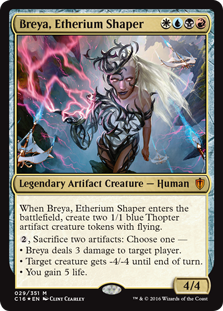
So far 20, 24 and 25 life have all be tried and comically have all made zero difference to the outcome of the games with hundreds played and despite aggro decks cropping up often. Aggro decks have been big beneficiaries of this commander cube sealed format. Having options on good legends all the way up the curve allows the aggressive decks to work even if they are missing something. Often you can't play your red deck because you don't have the one drop threats or you can't play the white because you don't have a finisher. The right commander cleanly fixes a problem your aggro deck has and almost feels like a mulligan safety net. We have seen a lot of Kytheon, a lot of Zurgo, a lot of Hazoret and Purphoros at the other end too.
The commander cube format is good. The games are more consistent, more interactive and longer. The only thing I see hurting this format for me is longevity. Commanders are played a lot over the course of a match and so even though you have more build options the feel of the games does get a bit samey after a while playing with or against a specific commander. The pool of good two or more coloured legends is just so small that you wind up seeing the same cards a lot. Seeing too much of a card is dull and so I will do other things to keep it fresh. I alluded to the fix for these things earlier although I have not tried it out as yet. I think by making starting library size 50 rather than 40 you provide a more effective nerf to the aggro decks than the life boost and you also address the longevity issue. You will still see a lot of the commanders but the deck diversity will offset that. Bigger decks need more cards and so more cards get played and a much much broader array of interactions between cards is then seen.
I can highly recommend this format and I suspect I can do so to both cube lovers and commander players alike. Starting with 25 life and building 50 card decks plus any legal commander you can name feels like the optimal balance for cube style play. It is fun, it is different, it is balanced, and it is highly diverse. And this is just the limited side of things! The options for constructed heads up commander decks, as commander players are already well aware, is near endless. I am not sure if I will ever get the stage where I do content on it however as it seems like it would just be incomplete commander content and not all that useful to anyone. My cube constructed content is already pretty irrelevant to most MtG players! "Here is half a commander deck that I built that wouldn't work in multiplayer" isn't really a thing. I should either just do some heads up commander content or stick to cube stuff I think. The middle ground between the two is full of great things but it doesn't seem like it is in need of documenting. That being said, I will absolutely be doing a write up on Oathbreaker when I have done some actual testing for it. By then I will likely have some extra insights into blending cube and commander too. If anyone
is interested in seeing some deck lists for any of the things mentioned in this article I will take requests so just slap them in the comments.
Something I've been considering for my cube.
ReplyDeleteDo you play multiplier or 1v1?
I only play 1v1, I am too impatient to wait for multiple people have turns before I get mine again!
ReplyDeleteGreat post! Im somewhat of a cube fiend. I started with YGO then quickly moved to magic. The commander/Oathbreaker cube is something I fiddled with and my play group loves it! We went with something slightly more unorthodox though. we found that if we dropped lands from the cube itself (aside from things that transform into lands) and used Gates/Life Lands in place of basics (from hand they come into play untapped) the games went smoother since we'd draft potential commanders from the pool. It does make the build a bit harder but allows for the Risk vs Reward potential of opening a good dual colored commander and rolling with it.
ReplyDeleteAgain, not for everyone but I've gotten some good feedback even from some "Modern Hard-@sses" that it was "more fun than they thought"
That is a really inspired idea. The land tension in a draft pool is huge and you completely remove it. That sounds really good for a number of cube formats and I will absolutely be trying it. While I fear this would lead to 4 and 5 colour goodstuff decks dominating in normal cubes with the removal of duals it sounds like the perfect way to do commander and oathbreaker events as the generals will put a counteracting incentive on the many coloured lists. Love it. Thanks for sharing.
Delete